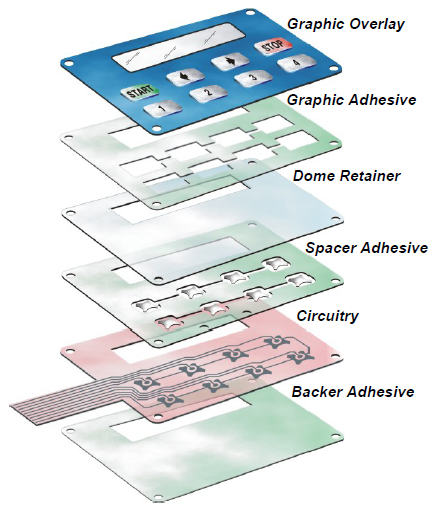Why Membrane Changes Are Important for Resilient Control Solution
Membrane buttons play an essential function in making sure the resilience and reliability of control systems throughout different markets. Their unique construction permits them to sustain challenging environmental aspects such as humidity, temperature level extremes, and physical wear. This strength not just extends the life expectancy of the systems they serve but likewise reduces upkeep demands. As we explore the multifaceted benefits of membrane layer buttons, it becomes noticeable that their relevance transcends mere functionality, affecting user experience and operational effectiveness. What additional implications do these attributes hold for the future of control system style?
Overview of Membrane Layer Switches
Membrane switches are flexible and trustworthy components typically utilized in various electronic control systems. These buttons contain a number of layers, consisting of a graphic overlay, a spacer layer, and a printed circuit layer. The graphic overlay offers both practical and visual layout, while the spacer layer guarantees that the switches are activated just when pressed. The published circuit layer has conductive traces that finish an electrical circuit when the membrane layer is pressed, enabling the tool to react to user inputs.
Membrane switches are often preferred in applications requiring a portable and lightweight layout, making them suitable for portable tools, medical tools, and commercial equipment. They can be personalized to meet details customer needs and can incorporate numerous attributes such as backlighting, tactile comments, and numerous shades. Membrane layer switches are resistant to dirt, wetness, and contaminants, making them appropriate for settings where longevity is important.
Advantages of Toughness
In several applications, the resilience of membrane switches over offers substantial benefits that enhance their overall performance and reliability. These switches are designed to withstand severe settings, making them optimal for use sought after conditions such as high moisture, extreme temperature levels, and exposure to chemicals. Their durable construction helps to protect against damages from physical impact, ensuring long-lasting performance and minimizing the demand for frequent replacements.
Furthermore, membrane layer switches are immune to deterioration, which is essential in applications where regular interaction occurs. This toughness translates to reduce upkeep expenses, as companies benefit from reduced downtime and fewer solution disruptions. Additionally, the encapsulated style of membrane changes safeguards inner elements from dust and moisture access, further adding to their lifespan.
An additional benefit is their ability to preserve consistent performance gradually. With a high tolerance for mechanical stress and anxiety, these buttons protect their tactile feedback and electrical stability, guaranteeing customer complete satisfaction. Eventually, the resilience of membrane switches not just improves functional effectiveness yet likewise cultivates self-confidence in their dependability, making them a favored option for control systems throughout numerous industries.
Applications in Different Industries
Sturdy control systems employing membrane switches locate comprehensive applications across a series of markets, each gaining from the one-of-a-kind attributes these buttons offer. In the medical market, membrane switches are important for gadgets such as patient monitors and analysis devices, where dependability and ease of cleansing are extremely important. Their resistance to dampness and pollutants ensures they keep capability in sterile settings.
The click here to find out more automotive market leverages membrane layer switches for control panel controls and infomercial systems, where they supply streamlined, inconspicuous interfaces that enhance customer experience. These buttons are likewise made to withstand harsh conditions, consisting of exposure to severe temperature levels and vibrations.
In commercial setups, membrane buttons are frequently made use of in machinery control board, providing tactile feedback and toughness essential for high-usage applications. Their weblink ability to stand up to chemicals makes them ideal for making environments where spills and impurities are frequent.

Customer electronic devices, such as cooking area home appliances and push-button controls, additionally utilize membrane layer buttons for their versatility and cost-effectiveness. Generally, the flexibility and durable nature of membrane changes make them indispensable across various sectors, making certain efficient operation and longevity in control systems.
Layout and Visual Allure
While performance is vital, the design and aesthetic appeal of control systems geared up with membrane switches play an important role in user engagement and total experience (membrane switch). The visual layout of these buttons can significantly affect user perception and interaction. A well-designed membrane layer button boosts the beauty of the device, making it much more attractive to users and promoting a connection between the customer and the item
Membrane switches over supply a large amount of versatility in design, enabling suppliers to tailor graphics, colors, and structures to line up with brand name Clicking Here identity and item visual appeals. The usage of vivid shades and unique patterns can attract interest, while responsive responses can reinforce the customer's interaction with the device. In addition, the capacity to integrate LED indications and backlighting into the membrane layer switch design provides both useful and aesthetic advantages, boosting visibility and usability in numerous atmospheres.

Enhancing Customer Experience

In addition, membrane switches can be tailored to integrate graphical user interfaces, boosting usability by providing information in a clear and instinctive way (membrane switch). This personalization can include icons, labels, and color coding that overview users via complicated performances with convenience. In addition, their convenience permits for integration in various atmospheres, guaranteeing consistent efficiency whether in commercial equipment or consumer electronics
The sturdiness of membrane switches likewise plays a crucial duty in individual experience. By enduring harsh conditions and extended usage, these buttons minimize the possibility of system failings, thus promoting reliability and individual self-confidence. Eventually, the strategic use of membrane changes not just elevates performance yet also considerably enhances user interaction with control systems, making them a vital part in modern layout.
Verdict
